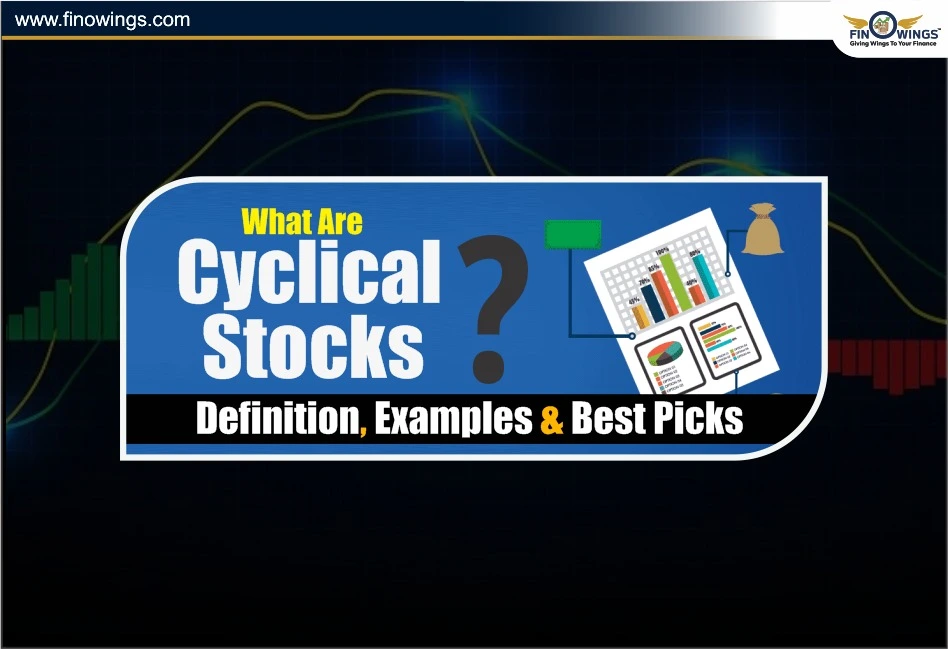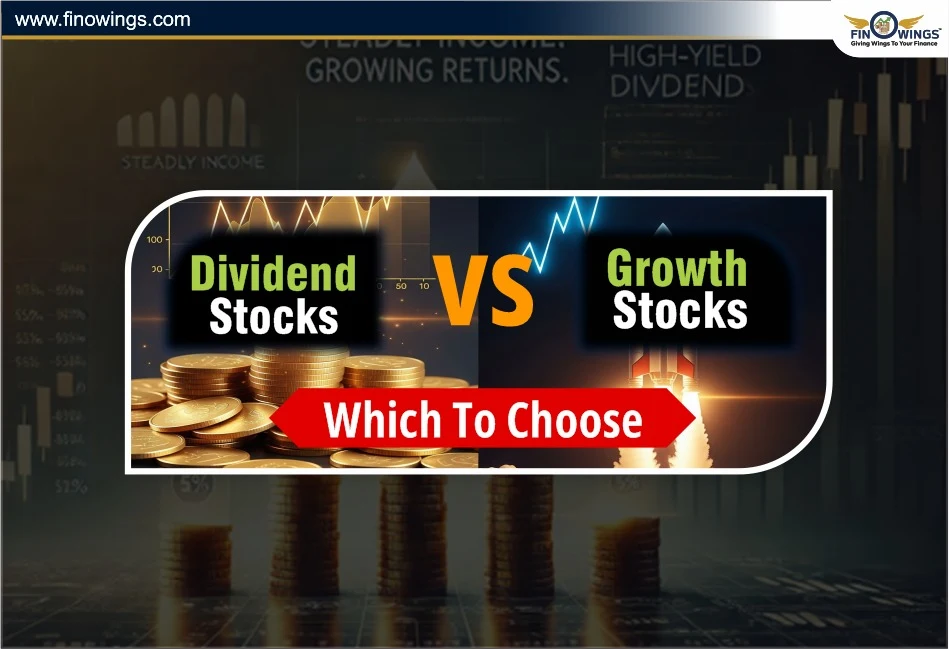Home >> Blog >> What Are Cyclical Stocks? Definition, Examples & Best Picks
What Are Cyclical Stocks? Definition, Examples & Best Picks

Table of Contents
Understanding how various stock kinds perform under various economic conditions is essential to investing in the stock market. Among these, cyclical stocks are especially intriguing since their performance aligns with economic cycles.
Cyclical equities are likely to beat the market while the economy is growing. However, these equities lose value during economic downturns, frequently significantly. Making better timing and portfolio decisions is made possible by comprehending and identifying this behavior.
This article will explain what cyclical stocks are, how they work, provide examples of cyclical industries, and list the top cyclical stocks in India and around the world.
What Are Cyclical Stocks?
Cyclical stocks refer to the stocks of companies whose business cycle has a significant impact on the performance of the company. Economic booms and recessions are business cycles. Once the economy is up, people will buy more high-end and luxury products, travel and other products.
Conversely, in the case of recessions in businesses, the profits and revenues of these businesses are reduced drastically when people cease to spend. This means that their share prices will also fall leading to the fact that investing in such businesses at a time of economic downturn is risky. Cyclical stocks go through booms and busts, as does the economy.
Example:
During economic booms and recessions, Tata Motors and Maruti Suzuki, which sell passenger and luxury cars, perform well and have high stock prices.
During a recession, people stop buying cars, and these companies' sales drop; as a result, their share prices drop as well.
Common Characteristics of Cyclical Stocks
Cyclical stocks have a few common characteristics that make identification a relatively straightforward task.
1. Profits are Sensitive to Economic Changes: Their profits greatly increase and decrease as the economy expands and contracts.
2. High beta: They are more volatile in comparison to defensive stocks.
3. Irregular profits: Unlike utilities or FMCG, which are stable sectors, cyclical companies are subject to inconsistent profits, whether it be a quarter or a year.
4. Discretionary Demand: Their products are non-essentials, and people can delay purchasing them.
Cyclical vs Non-Cyclical Stocks
|
Feature |
Cyclical Stocks |
Non-Cyclical Stocks |
|
Economic Sensitivity |
Highly dependent on economic growth |
Perform steadily across all cycles |
|
Examples |
Automobiles, Airlines, Hotels, Steel |
FMCG, Pharma, Utilities |
|
Risk Level |
Higher volatility |
Lower volatility |
|
Ideal for |
Aggressive investors |
Conservative investors |
|
Revenue Pattern |
Fluctuates with the business cycle |
Stable, predictable earnings |
Cyclical stocks can provide strong growth during recovery phases, but they can also drop significantly during a recession. This is where the importance of diversification in a portfolio comes in.
Types of Cyclical Stocks
You can categorise cyclical stocks depending on which industries they pertain to. Here are the most popular types:
1. Consumer Discretionary Stocks
Offer non-essential products and services including apparel, jewelry, cars and vacation.
Examples: Titan, Raymond, Bata India.
2. Industrial & Infrastructure Stocks
Deal with capital goods, building and cement, and they profit from inflation as infrastructure is developed and the economy grows.
Examples: L&T, UltraTech Cement, ABB India.
3. Banking and Financial Stocks
These are the NBFCs and banks. They perform well with low-interest rates and have high credit demand.
Examples: ICICI Bank, Bajaj Finance.
4. Commodity & Metal Stocks
With economic activity, the price of metals like steel, copper, and aluminium rises.
Examples: Tata Steel, JSW Steel, Hindalco.
5. Real Estate Stocks
An increase in economic confidence and higher income leads to expansion in real estate stocks.
Examples: Godrej Properties, Oberoi Realty.
Cyclical Stocks India
These are the companies that are well known in India and are also considered cyclical:
|
Sector |
Example Companies |
|
Automobiles |
Tata Motors, Mahindra & Mahindra |
|
Cement |
UltraTech Cement |
|
Metals |
JSW Steel |
|
Banking |
Axis Bank |
|
Real Estate |
DLF, Godrej Properties |
|
Travel & Leisure |
IRCTC |
These companies perform well during periods of high GDP growth cycles and infrastructure expansion.
Best Cyclical Stocks for 2025
Analysts suggest buying cyclical stocks during the recovery and expansion phases of an economy. In India, some of the best cyclical stocks include:
|
Company |
Sector |
Why It’s Attractive |
|
Automobiles |
EV segment growth, rising domestic demand |
|
|
HDFC Bank |
Banking |
Strong loan growth, digital transformation |
|
JSW Steel |
Metals |
Benefiting from the infrastructure boom |
|
L&T |
Infrastructure |
Government’s CAPEX-led growth focus |
|
Indian Hotels |
Tourism |
Rising domestic travel demand |
|
UltraTech Cement |
Cement |
Real estate and infra growth support |
How to Invest in Cyclical Stocks
Timing and diversification are the keys to maximising the potential of cyclical stocks. Here’s how:
1. Identify the Economic Cycle- Investing in cyclical stocks is best during the early recovery phase of the economy, where snapshots of growth are measured in terms of GDP, industrial production, and consumer confidence.
2. Use Fundamental Indicators- Look for improving earnings and order books in cyclical sectors and growing volumes.
3. Diversify Across Sectors- Balance your portfolio by adding stocks from defensive sectors like FMCG or Pharma alongside your cyclical stocks.
4. Exit During Overheating- When the market becomes overpriced and starts to collapse, take your profits.
5. Monitor Macro Factors- Interest rates, commodity prices, and governmental actions affect cyclicals for various reasons.
Pros and Cons of Investing in Cyclical Stocks
|
Pros |
Cons |
|
During times of expansion in the economy, the returns are significantly higher. |
Can be extremely volatile when the economy is weak. |
|
Suitable for short to medium term trading. |
Must be timed correctly and watched closely. |
|
Available across various industries. |
Not appropriate for conservative ventures. |
Conclusion
Understanding the risks and investing in cyclical stocks is essential to any portfolio. They can go up in value very quickly as the economy is performing well, but can also get chaotic once things are poor.
There is a need to understand what cyclical stocks are and when to locate the best ones in case you are interested in making more profits. Cyclical investing involves stringent research, economic knowledge and controlled risk-taking in order to be successful.
Before buying any stocks, it is always better to gather some information about that stock. Read our detailed blog to learn how to analyse a stock for an informed decision.
DISCLAIMER: This blog is NOT any buy or sell recommendation. No investment or trading advice is given. The content is purely for educational and information purposes only. Always consult your eligible financial advisor for investment-related decisions.



















